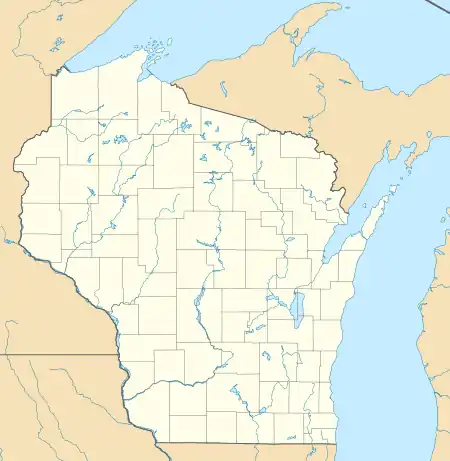Hilgen and Wittenberg Woolen Mill
The Hilgen and Wittenberg Woolen Mill is a former woolen mill located in Cedarburg, Wisconsin, United States. In 1864, in response to the demands of the U.S Civil War Frederick Hilgen, Diedrich Wittenberg, and Joseph Trottman planned to build a woolen mill to provide textile goods for the war effort. In 1865 and at a cost of $30,000 the mill was completed, the complex consisted of two limestone buildings outfitted with state of the art equipment coupled to turbines powered by Cedar Creek.[1] While completed too late to produce goods for the U.S Civil War the mill would be very successful and go on to produce blankets, and flannels.
Hilgen and Wittenberg Woolen Mill | |
 Hilgen and Wittenberg Woolen Mill | |
 | |
| Location | Cedarburg, Wisconsin |
|---|---|
| Coordinates | 43°18′4.3″N 87°59′20″W |
| Built | 1864 |
| Architectural style | Greek Revival |
| NRHP reference No. | 78000124 |
| Added to NRHP | December 22, 1978 |
1800s
Through the late 1800s the mill flourished, additions and a warehouse were built soon after the original construction. In 1872 the mill was incorporated as the Cedarburg Woolen Mill with Dietrich Wittenberg as president.[1] In 1880 the company built a branch factory in Grafton for the production of worsted yarn, the only mill of its kind west of Philadelphia,[1] the next year in 1881 the mills dam washed out during heavy spring flooding.[2] By 1893 the mill had expanded from its original two buildings to twelve, including the factory, store, offices, shipping department, coach house, warehouses, bleach house, and dye house across Bridge Street, connected to the factory basement by a tunnel.[1] In 1896 steam power became the primary power source at the mill.[3] A boiler house and engine house were built to provide the steam power, an 85hp main engine was installed to power the machines, along with two steam powered fire pumps, and a 45hp engine coupled to a generator which provided the building—as well as the Wittenberg Mansion across the street—with the first electric light in the city of Cedarburg.[2][1][4]
1900s
The last major mill expansion occurred in 1907 when a third floor was added to the factory building. The mill began its decline during the Great Depression when it was idled and in 1933 the mill dam washed out for the second time. Construction of a new dam, designed by local engineer Charles Whitney, began in 1938 and was completed in 1939 as a Public Works Administration project for the City of Cedarburg.[5][6][7] The millpond created by the new dam became a popular swimming area, even featuring an artificial beach on the bank opposite the mill. During World War II the mill increased production to provide woolen blankets for the war effort, however after WWII the mill would resume its decline. In 1945 the mill stopped its mechanical weaving operations, but continued hand weaving of specialty products.[3] The swimming area suffered from poor water quality and in 1959 the City built a pool and closed the swimming beach.[8] In 1968 the mill declared bankruptcy and shut down, the Wittenberg family, who still owned the mill after its closure, accepted an offer from a developer who was going to tear down the mill and construct a gas station. However mayor Stephen Fisher was able to hold off demolition until an alternate buyer who would preserve the buildings was found. In January 1972 Jim Pape bought the mill buildings for his winery business saving it from demolition.[3] In 1978 the mill buildings were added to the National Register of Historic Places.[9][1][10]
2000s
Currently, the mill complex is referred to as Cedar Creek Settlement[11] and houses a restaurant in the former boiler house and specialty stores throughout the other buildings. The former swimming beach is now Boy Scout Park.
See also
| Mill Name | Year Built | Products Produced | Notes |
|---|---|---|---|
| Concordia Mill | 1853 | Grain | Dam washed out and removed 1996 |
| Excelsior Mill, later Cedarburg Wire and Nail Factory | 1871 | Grain, lumber, drawn steel, hydroelectricity | |
| Columbia Mill | 1843 | Grain | Demolished |
| Cedarburg Mill | 1844 | Grain | Rebuilt 1855 with current stone structure |
| Hilgen and Wittenberg Woolen Mill | 1864 | Textiles |
References
- Donath, Donald; Pape, James B. (July 1978). "Hilgen and Wittenberg Woolen Mill". NRHP Inventory-Nomination Form. National Park Service. Retrieved 2017-01-26.
- "Early history of Ozaukee County, Wisconsin". University of Wisconsin-Madison Libraries. Retrieved 2020-01-01.
- "history". The Shops of Cedar Creek Settlement. Retrieved 2020-12-09.
- "Image 2 of Sanborn Fire Insurance Map from Cedarburg, Ozaukee County, Wisconsin". Library of Congress, Washington, D.C. 20540 USA. Retrieved 2021-01-06.
- "Wisconsin Department of Natural Resources (DNR) | Wisconsin DNR". dnr.wisconsin.gov. Retrieved 2020-12-08.
- Reflections of old Cedarburg. Rappold, Edward A. (3rd ed.). Cedarburg, Wis.: E.A. Rappold. 1994. ISBN 0-9625597-2-5. OCLC 10448309.CS1 maint: others (link)
- Inspection and Evaluation Report Woolen Mill Dam Cedar Creek (Rep.). (2007). Mead & Hunt
- "Swimming Pool". Ozaukee County, WI. Retrieved 2021-01-21.
- "National Register Information System". National Register of Historic Places. National Park Service. July 9, 2010.
- "Hilgen and Wittenberg Woolen Mill". Wisconsin Historical Society. Retrieved 2017-01-26.
- "Welcome to TheShops of CedarCreek Settlement". The Shops of Cedar Creek Settlement. Retrieved 2020-12-09.